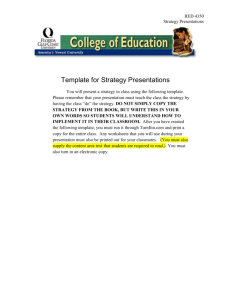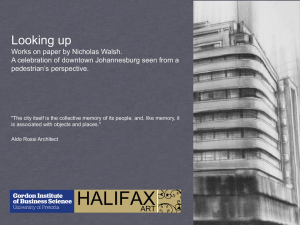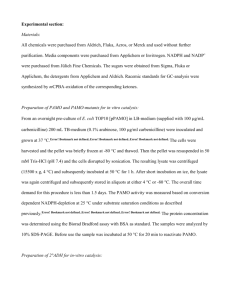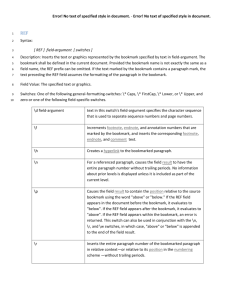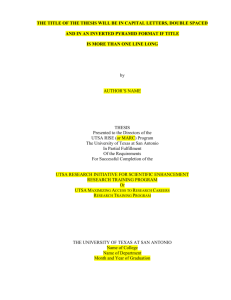Chapters 1 – 2
advertisement
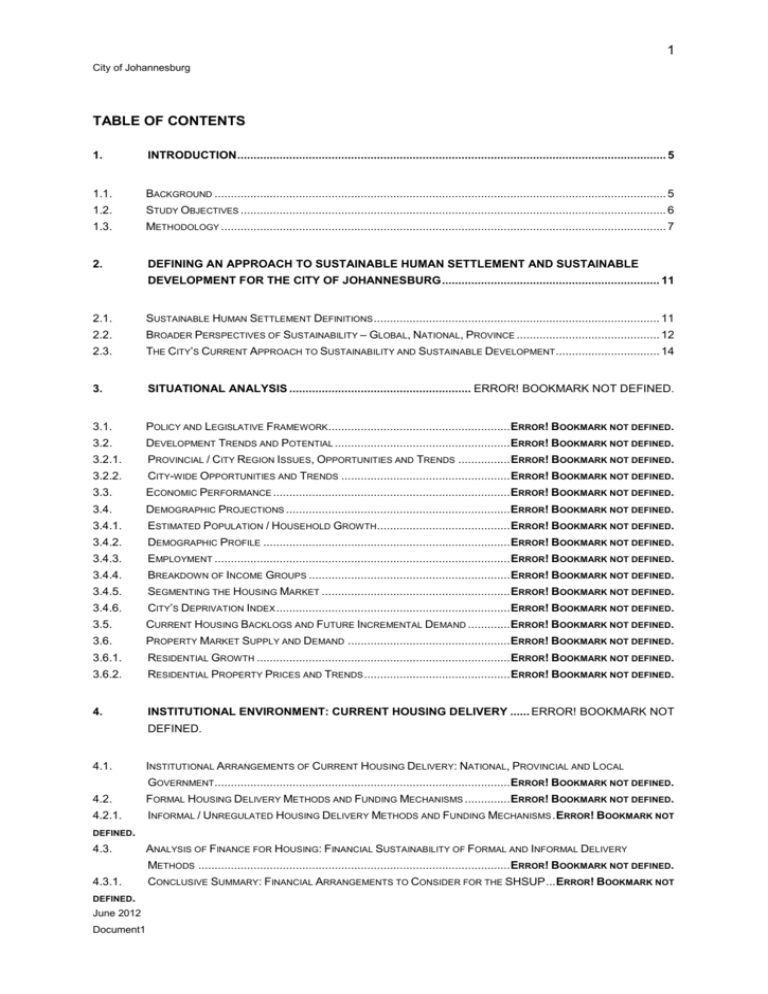
1 City of Johannesburg TABLE OF CONTENTS 1. INTRODUCTION .................................................................................................................................... 5 1.1. BACKGROUND ........................................................................................................................................... 5 1.2. STUDY OBJECTIVES ................................................................................................................................... 6 1.3. METHODOLOGY ......................................................................................................................................... 7 2. DEFINING AN APPROACH TO SUSTAINABLE HUMAN SETTLEMENT AND SUSTAINABLE DEVELOPMENT FOR THE CITY OF JOHANNESBURG ................................................................... 11 2.1. SUSTAINABLE HUMAN SETTLEMENT DEFINITIONS ........................................................................................ 11 2.2. BROADER PERSPECTIVES OF SUSTAINABILITY – GLOBAL, NATIONAL, PROVINCE ............................................ 12 2.3. THE CITY’S CURRENT APPROACH TO SUSTAINABILITY AND SUSTAINABLE DEVELOPMENT ................................ 14 3. SITUATIONAL ANALYSIS ........................................................ ERROR! BOOKMARK NOT DEFINED. 3.1. POLICY AND LEGISLATIVE FRAMEWORK ........................................................ ERROR! BOOKMARK NOT DEFINED. 3.2. DEVELOPMENT TRENDS AND POTENTIAL ...................................................... ERROR! BOOKMARK NOT DEFINED. 3.2.1. PROVINCIAL / CITY REGION ISSUES, OPPORTUNITIES AND TRENDS ................ ERROR! BOOKMARK NOT DEFINED. 3.2.2. CITY-WIDE OPPORTUNITIES AND TRENDS .................................................... ERROR! BOOKMARK NOT DEFINED. 3.3. ECONOMIC PERFORMANCE ......................................................................... ERROR! BOOKMARK NOT DEFINED. 3.4. DEMOGRAPHIC PROJECTIONS ..................................................................... ERROR! BOOKMARK NOT DEFINED. 3.4.1. ESTIMATED POPULATION / HOUSEHOLD GROWTH......................................... ERROR! BOOKMARK NOT DEFINED. 3.4.2. DEMOGRAPHIC PROFILE ............................................................................ ERROR! BOOKMARK NOT DEFINED. 3.4.3. EMPLOYMENT ........................................................................................... ERROR! BOOKMARK NOT DEFINED. 3.4.4. BREAKDOWN OF INCOME GROUPS .............................................................. ERROR! BOOKMARK NOT DEFINED. 3.4.5. SEGMENTING THE HOUSING MARKET .......................................................... ERROR! BOOKMARK NOT DEFINED. 3.4.6. CITY’S DEPRIVATION INDEX ........................................................................ ERROR! BOOKMARK NOT DEFINED. 3.5. CURRENT HOUSING BACKLOGS AND FUTURE INCREMENTAL DEMAND ............. ERROR! BOOKMARK NOT DEFINED. 3.6. PROPERTY MARKET SUPPLY AND DEMAND .................................................. ERROR! BOOKMARK NOT DEFINED. 3.6.1. RESIDENTIAL GROWTH .............................................................................. ERROR! BOOKMARK NOT DEFINED. 3.6.2. RESIDENTIAL PROPERTY PRICES AND TRENDS ............................................. ERROR! BOOKMARK NOT DEFINED. 4. INSTITUTIONAL ENVIRONMENT: CURRENT HOUSING DELIVERY ...... ERROR! BOOKMARK NOT DEFINED. 4.1. INSTITUTIONAL ARRANGEMENTS OF CURRENT HOUSING DELIVERY: NATIONAL, PROVINCIAL AND LOCAL GOVERNMENT........................................................................................... ERROR! BOOKMARK NOT DEFINED. 4.2. FORMAL HOUSING DELIVERY METHODS AND FUNDING MECHANISMS .............. ERROR! BOOKMARK NOT DEFINED. 4.2.1. INFORMAL / UNREGULATED HOUSING DELIVERY METHODS AND FUNDING MECHANISMS . ERROR! BOOKMARK NOT DEFINED. 4.3. ANALYSIS OF FINANCE FOR HOUSING: FINANCIAL SUSTAINABILITY OF FORMAL AND INFORMAL DELIVERY METHODS ................................................................................................ ERROR! BOOKMARK NOT DEFINED. 4.3.1. DEFINED. June 2012 Document1 CONCLUSIVE SUMMARY: FINANCIAL ARRANGEMENTS TO CONSIDER FOR THE SHSUP ... ERROR! BOOKMARK NOT 2 City of Johannesburg 4.4. HOUSING INSTITUTIONS, CAPACITY AND OPERATIONS ................................... ERROR! BOOKMARK NOT DEFINED. 4.4.1. CURRENT HOUSING CAPACITY AND OPERATIONS ......................................... ERROR! BOOKMARK NOT DEFINED. 4.4.2. CITY OF JOHANNESBURG’S HOUSING INSTITUTIONS AND MOE’S .................... ERROR! BOOKMARK NOT DEFINED. 4.4.3. EXTERNAL HOUSING INSTITUTIONS IN JOHANNESBURG ................................. ERROR! BOOKMARK NOT DEFINED. 4.4.4. GAPS AND CHALLENGES OF CITY OF JOHANNESBURG’S HOUSING ADMINISTRATION STRUCTURES ........... ERROR! BOOKMARK NOT DEFINED. 5. LESSONS LEARNT FROM PREVIOUS MECHANISMS OF HOUSING DELIVERY ................ ERROR! BOOKMARK NOT DEFINED. 5.1. RATIONALE AND CRITERIA FOR PROJECT SELECTION ...................................... ERROR! BOOKMARK NOT DEFINED. 5.2. SELECTED CASE STUDY PROJECTS ............................................................. ERROR! BOOKMARK NOT DEFINED. 5.3. SUSTAINABILITY THEMES FOR ANALYSIS ...................................................... ERROR! BOOKMARK NOT DEFINED. 5.4. SUMMARY OF KEY ISSUES AND LESSONS LEARNT IN PAST AND CURRENT HOUSING DEVELOPMENTS ....... ERROR! BOOKMARK NOT DEFINED. 6. KEY FINDINGS, CHALLENGES AND CONCLUSIVE SUMMARY ............ ERROR! BOOKMARK NOT DEFINED. 6.1. KEY ISSUES/FEATURES .............................................................................. ERROR! BOOKMARK NOT DEFINED. 7. SPATIAL PROPOSALS ............................................................ ERROR! BOOKMARK NOT DEFINED. 7.1. FUTURE HOUSING PROVISION PRINCIPLES ................................................... ERROR! BOOKMARK NOT DEFINED. 7.2. IDENTIFICATION OF STRATEGIC AREAS ......................................................... ERROR! BOOKMARK NOT DEFINED. 7.2.1. PRIORITY PUBLIC TRANSPORT NETWORK AREAS ......................................... ERROR! BOOKMARK NOT DEFINED. 7.2.2. EXISTING HOUSING PROJECT AREAS .......................................................... ERROR! BOOKMARK NOT DEFINED. 7.2.3. REDEVELOPMENT AREAS ........................................................................... ERROR! BOOKMARK NOT DEFINED. 7.2.4. CITY REGION CONSOLIDATION AND INFILL AREAS ......................................... ERROR! BOOKMARK NOT DEFINED. 7.2.5. EXPANSION AREAS .................................................................................... ERROR! BOOKMARK NOT DEFINED. 8. HOUSING DEMAND AND SUPPLY OPPORTUNITIES MODEL ................ ERROR! BOOKMARK NOT DEFINED. 8.1. INTRODUCTION .......................................................................................... ERROR! BOOKMARK NOT DEFINED. 8.2. DESIGN OF THE DEMAND AND SUPPLY OPPORTUNITIES MODEL ...................... ERROR! BOOKMARK NOT DEFINED. 8.3. ASSUMPTIONS FOR BASE SCENARIO ............................................................ ERROR! BOOKMARK NOT DEFINED. 8.3.1. LAND AVAILABILITY .................................................................................... ERROR! BOOKMARK NOT DEFINED. 8.3.2. INCOME GROUP ALLOCATION ..................................................................... ERROR! BOOKMARK NOT DEFINED. 8.3.3. HOUSING TYPOLOGY ALLOCATION .............................................................. ERROR! BOOKMARK NOT DEFINED. 8.3.4. PHASING OF DEVELOPMENT ....................................................................... ERROR! BOOKMARK NOT DEFINED. 8.4. HOUSING DEMAND AND OPPORTUNITIES MODEL: BASE SCENARIO RESULTS ... ERROR! BOOKMARK NOT DEFINED. 8.5. ALTERNATIVE DEVELOPMENT OPTIONS ....................................................... ERROR! BOOKMARK NOT DEFINED. 8.6. CONCLUSIVE SUMMARY ............................................................................. ERROR! BOOKMARK NOT DEFINED. 9. IMPLEMENTATION STRATEGY .............................................. ERROR! BOOKMARK NOT DEFINED. June 2012 Document1 3 City of Johannesburg 9.1. INTRODUCTION .......................................................................................... ERROR! BOOKMARK NOT DEFINED. 9.2. PRIORITY STRATEGIC INTERVENTIONS ......................................................... ERROR! BOOKMARK NOT DEFINED. 9.3. CONCLUSION ............................................................................................ ERROR! BOOKMARK NOT DEFINED. LIST OF FIGURES Figure 1: SHSUP Process and Outputs Figure 2: Development Drivers and Paradigm Source: Joburg 2040: Growth and Development Strategy Figure 3: City of Johannesburg Household Forecast (2010-2030) Figure 4: Population Increase (2001-2030) – Base Scenario Figure 5: Number of Households Increase (2001-2030) – Base Scenario Figure 6: CoJ Age Profiles Figure 7: Schooling Levels within CoJ Figure 8: Segmenting the Housing Market Figure 9: Long Term Average Residential Stand Size Trend Figure 10: Average Building Size According to Building Year Figure 11: Proportion of full Title Properties – Long Term Trend Figure 12: Full Title Average Land Utilisation Rate Figure 13: Dwelling Houses Completed Figure 14: Flats and Townhouses Completed Figure 15: The Housing Finance Spectrum in the FSC Target Market (thousands households) Figure 16: CoJ USDG Year on Year Capital Allocation by Division 2012-2015 Figure 17: Demand and Supply Opportunities Model: Concept LIST OF TABLES Table 1: Stakeholder Engagement Programme Table 2: Key Economic Indicators of the Market Area, 2011 Table 3: City of Johannesburg Population Forecast (2010-2030) Table 4: City of Johannesburg Household Forecast (2010-2030) Table 5: Low and High Scenario Assumptions Table 6: Key socio-economic indicators of the City of Johannesburg Table 7: Households Segments Table 8: Criteria applied in compilation respective Deprivation Domains Table 9: Demand per Income Category Table 10: Residential buildings completed by size of dwelling house (City of Johannesburg MM) Table 11: Flats and Townhouses Completed (Johannesburg MM) Table 12: Human Settlements key functions, roles and responsibilities of three spheres of Government Table 13: Provides a summary of the various delivery methods and funding mechanisms that are currently available Table 14: Summary of Informal Delivery Methods and Funding Mechanisms Table 15: 5 year Housing Delivery Targets for the City of Johannesburg’s Department of Human Settlements Table 16: Social Housing Roles and Responsibilities Table 17: JOSHCO, JDA and JPC and Responsibilities Table 18: External Housing Institutions Table 19: Case Study Projects Selected Table 20: Summary of Lessons Learnt Table 21: Summary of the Development Principles Table 22: Strategic Areas Table 23.1-23.3: Housing Typologies (Low, Medium, High) Table 24: Land Use Budget Process Example Table 25: Joburg: Standards Used in Land Use Budget Table 26: Assumptions for Base Scenario: Income Composition per Strategic Area Table 27.1-27.11: Typologies per Strategic Area Table 28.1: Total Dwelling Units Table 28.2: Total Housing Typologies Table 28.3: Dwellings/Hectare Table 28.4: Priority Table 28.5: Total Unit Costs Table 28.6: Tenure Split: Total Dwelling Units Table 28.7: Community Facility Model June 2012 Document1 4 City of Johannesburg Table 29: Alternative Development Options: Base Scenario Table 30: The Breadth of Options upon which Households might consider making an Investment Table 31: Summary of Incentives available to the private sector Table 32: Functional Responsibilities of the Sustainable Services Cluster LIST OF MAPS Map 1: Regional Context Map 2: Spatial Structure Map 3: Provincial Housing Programme Focus Areas Map 4: Stormwater backlogs Map 5: Gravel roads backlogs Map 6: Power hot spots Map 7: Sanitation hot spots Map 8: Water hot spots Map 9: Transport and Movement Network Map 10: Strategically City-owned Land Map 11: Johannesburg LSM Profile Map 12: Spatial Manifestation of the Deprivation Index Map 13: Informal Settlement, 2011 Map 14: Region A-G: Backyard Units 2009 Map 15: Johannesburg Residential Growth (2001-2009) Map 16: Strategic Areas Map 16.1-16.4: Strategic Areas Map 17: Strategic Areas Map 17.1: Consolidation and Infill Areas: North Eastern Suburbs LIST OF ANNEXURES ANNEXURE A: Towards an Approach to Sustainability and Sustainable Development for the CoJ ANNEXURE B: Policy Tables: National B1, Provincial B2, Local B3 ANNEXURE C: Housing Typology Case Studies ANNEXURE D: Key Elements to Guide the Spatial Dimension of the SHSUP ANNEXURE E: Strategic Areas Identified ANNEXURE F: Market Analysis per Strategic Area ANNEXURE G: Housing Typologies and Design Guidelines ANNEXURE H: Building Housing Finance Systems to Support Sustainable Human Settlements ANNEXURE I: Property Economics Perspective on the Housing Demand and Opportunities Model ANNEXURE J: Strategic Levers, Objectives and Interventions ANNEXURE K: Informal Backyard Rental Accommodation: A Summary of Issues and Policy Emanating from Certain Previous Research ANNEXURE L: Summary Overview of Incentives June 2012 Document1 5 City of Johannesburg 1. INTRODUCTION It is currently estimated that 38% per cent of Africa’s population, 297 million people, live in urban areas. By 2030, this figure is expected to increase to approximately 54% of a projected population of around 1,405 million (UNCHS 2001a). Africa’s rate of urbanisation of 3.5% per year represents the highest in the world. The City of Johannesburg is one of the 40 cities in Africa that currently host populations of more than one million residents and it is expected that by 2015 more than 70 cities will be included within this list. Southern Africa and South Africa in particular, are among the leading region in terms of increasing urbanisation in Africa. It is a realistic expectation that the City will continue to play a prominent role in absorbing the pressures of urbanisation in decades to come. The reasons for rapid growth of urban populations include overall high population growth rates, and ‘pull factors’ such as opportunities for employment, education, and improved access to health care which attract people from urban areas. There are also many social challenges associated with urbanisation, such as migration to find employment and greater income security. In many urban areas rates of economic growth and infrastructure development have lagged urbanisation rates, resulting in high levels of unemployment, inadequate standards of housing and services, and impacts on human health and development. Environmental disasters and conflicts have also caused many people to flee rural areas and to seek refuge in urban centres. Slums often lack access to many essential services such as water, sanitation, and waste disposal, whilst increased pressures of pollution on the environment are detrimental to human health. The United Nations Millennium Development Goals are aimed at achieving sustainable human settlements where the quality of life is improved and maintained in terms of both physical or spatial and emotional well-being. The Brundtland Commission, defines sustainability as “…meeting the needs of the present generation without compromising the ability of future generations to meet their own needs”. Source: http://www.unep.org/dewa/Africa/publications/aeo-1/203.htm The Republic of South Africa has experienced 18 years of democracy. However, the challenges associated with rapid urbanisation and growth have necessitated the need to rethink the role of settlements in terms of City building, urban form and aspects of sustainability. 1.1. Background During 2011/12 the City has interacted extensively with the Department of National Treasury whilst developing the Built Environment Performance Plan (BEPP). The BEPP allows the City to access Urban Settlement Development Grant (USDG) funding. During these interactions, it was agreed that a June 2012 Document1 6 City of Johannesburg more efficient utilisation of USDG funding needed to be explored due to the limitations of the typical “RDP type” housing model and the questionable sustainability of the urban form it has delivered. Additionally, the City’s review of the City’s Growth and Development Strategy during 2011 (GDS 2040) and the escalating importance and demand for sustainable service delivery has necessitated a rethinking of the City’s stance on sustainability and its implications on human settlements. The combination of the BEPP and GDS 2040 processes necessitated the enhancement of the Spatial Development Framework (SDF) and Growth Management Strategy (GMS) philosophy and led to the inception of the Sustainable Human Settlement Urbanisation Plan (SHSUP) process. The Sustainable Human Settlements Urbanisation Plan (SHSUP) has been developed to i) reflect on current and future demand and growth in terms of urbanisation trends and projections; ii) demonstrate and propose solutions to the current dysfunctional spatial form; and iii) direct existing and future resources towards making fundamental changes to achieve the objectives and aspects associated with Sustainable Human Settlements. 1.2. Study Objectives The purpose of the Sustainable Human Settlement Urbanisation Plan (SHSUP) is to craft a future development paradigm in relation to accommodation provision within the City from 2012 – 2030 and beyond, to specifically address the strategic responses and interventions required. In so doing, the SHSUP will demonstrate how the City can achieve its goal of adequate and appropriate supply of serviced public land and building stock as well as facilitating private sector developments within the most strategic locations. This paradigm, informed by the City’s Growth and Development Strategy is founded on a number of emerging principles including: securing and developing on locations that support the objectives of the Spatial Development Framework; diversifying accommodation and delivery options (i.e. developers); aligning the development of accommodation concurrently with social / physical infrastructure accelerating the delivery of rental stock; and realising a 1:1 ratio in respect of “give-away” v “rental” stock. Aligned to GDS 2040, the SHSUP contributes to Outcome 2 of the GDS which demands “the provision of a resilient, liveable, sustainable urban environment underpinned by infrastructure supportive of a low-carbon economy”. Additionally, in line with the Executive Mayor’s State of the City Address (2012) the development of the SHSUP will assist in the implementation of Key Flagship Programme 5 which is based on transforming Informal Settlements to Sustainable Human Settlements. It is anticipated that the SHSUP will be aligned with strategies co-ordinated through the Sustainable Services Cluster amongst others. June 2012 Document1 7 City of Johannesburg The detailed objectives of the SHSUP are noted below. These were derived from the Terms of Reference developed to assist in the formulation of the document and the processes associated with its completion. Confirm and quantify formal and informal accommodation backlogs and growth potential; Identify strategic locations within GMS priority areas for residential growth; Determine the desired urban form and typology options in these strategic locations; Prioritise and phase the implementation of the highest and best strategic locations, noting implications for the City; Development of an accommodation model to assist in identifying and assessing demand and opportunities in future areas for delivery; and Recommend key levers and other planning, institutional and financial tools, policies, programmes, and strategies to resolve critical issues in unlocking access to accommodation in the formal and informal markets. 1.3. Methodology The Phases associated with the development of the SHSUP are outlined in the following Figure 1 and narrative that follows. Figure 1: SHSUP Process and Outputs June 2012 Document1 8 City of Johannesburg Phase 1: Analysis, Synthesis and Gap Identification Analyse information (existing and new) found in order to produce a clear coherent synthesis of current housing delivery, institutional capacity and systems and future demand; Develop income and affordability categories for target user groups; Present and test research and findings as well as affordability categories with key stakeholders; Identify what the problems, gaps and needs are in the current housing system: o quantum of housing demand, o institutional mechanisms and capacity for delivery o financial systems. Phase 2: Development of Principles and Scenarios Formulation of an agreed set of principles that underpin provision of all future housing; Developing an agreed set of scenarios for future housing provision based on: o The desired distribution of housing provision across certain agreed upon strategic locations in the City of Johannesburg; o The expected population growth rate and demographic profile for future housing demand; o The target socio-economic user groups for future housing demand in specific strategic locations across the City; o Communicate and Test the agreed set of principles and scenarios with key stakeholders and expert groups. Phase 3: Modelling of Demand and Opportunities for Supply Developing a City-wide model of housing opportunities in an agreed format based on the findings of the Analysis (Phase 1) and the agreed Principles and Scenarios in Phase 2; Assessing the Desired Yield of housing units per strategic area - including testing against local area-based planning frameworks; Identification of specific strategic nodes and precincts within which to develop housing options; Develop a comprehensive chart of housing opportunities per strategic node or precinct that clearly communicates: o Appropriate Housing Typologies to be provided per target User Group; Quantum of housing units that can and should be provided per user group and per typology in respective locations; Estimated unit cost of providing each type of housing unit in respective locations; Total area of land needed to provide desired number of units in respective locations, related to the typology selected; o Present draft findings to key stakeholders and expert groups in order to discuss content. Phase 4: Develop a practical Implementation Plan with cost estimates Comprehensive set of actions needed to be taken by the City in order to realise the desired housing supply quantified and modelled in the strategic locations; June 2012 Document1 9 City of Johannesburg Detailing of a set of institutional and financial mechanisms for delivery ; Indicative supporting social infrastructure types and associate costs required to meet the demands and proposals in the various locations identified; Develop prioritisation criteria and phasing of prioritised actions in collaboration with the client, key stakeholders and expert advisory groups. Assignment of roles and responsibilities for implementation of various components of the supply chain; Workshopping the implementation plan, prioritising, allocation of roles and responsibilities and phasing with key stakeholders and expert advisory groups. Project Resources and Internal Co-ordination Utilising USDG funds, the City was able to secure additional capacity to complete the SHSUP using external service providers. In addition to a lead consultant project team, an advisory panel (coordinated by “Work in Development”) have been appointed to assess and act as a sounding board for the proposals made by the consultant team and project coordinator. Furthermore, a Stakeholder Steering Committee comprising all City departments and Municipal Entities has been formed in order to update and solicit input from the various stakeholders on a phase by phase basis. 1. Project Coordinator: Development Planning and Facilitation (DPF) 2. Consulting Team 3. Advisory Group 4. Technical Committee: a. DPF b. Human Settlements c. Lead Consultant d. Advisory Panel 5. Steering Committee – all Departments and Municipal Entities Table 1 below illustrates the various engagements that took place during the completion of the SHSUP. Table 1: Stakeholder Engagement Programme Advisory / Stakeholder Group Stakeholder Steering Committee Advisory Group Date 06 / 12 / 11 13 / 02 /12 Stakeholder Steering Committee 24 / 02 / 12 Advisory Group and break away groups 19 / 03 / 12 Advisory Group 16 / 04 / 12 Phase 3: Modelling results / Methodology Stakeholder Steering Committee 11 / 05 / 12 Advisory Group 14 / 05 / 12 Phase 3 : Modelling Detail / Prelim Implementation Themes Phase 4: Implementation plan June 2012 Document1 Purpose Inception Meeting Phase 1: Status Quo Information and Analysis Presentation Phase 1: Status Quo Information and Analysis Presentation Phase 2: Development Principles and Strategic locations 10 City of Johannesburg Stakeholder Steering Committee June 2012 Document1 15 June 2012 Phase 4 and consolidated document 11 City of Johannesburg 2. DEFINING AN APPROACH TO SUSTAINABLE HUMAN SETTLEMENT AND SUSTAINABLE DEVELOPMENT FOR THE CITY OF JOHANNESBURG A common vision on and understanding of sustainable human settlement and sustainable development is crucial to moving towards more sustainable human settlements for the City. Responses to urban development and management need to consider integrated and new responses to evolving challenges in the implementation of sustainable development to move toward the vision of sustainability (Maiello et al., 2011). Furthermore, the SHSUP needs to establish the platform and framework to support a convincing and credible shift from the provision of housing and accommodation per se to a more holistic concept of sustainable human settlements. The following chapter of the report provides an outline of the concepts of Sustainable Human Settlement and Sustainable Development and considers how these concepts have been applied and utilised within the City of Johannesburg. Annexure A provides a more comprehensive overview of the theoretical aspects of sustainability. 2.1. Sustainable Human Settlement Definitions The concepts of Sustainable Human Settlement and Sustainable Development are frequently used interchangeably and whilst they do share some common aspects, it is important to distinguish between their respective features. The concept of Sustainable Development is normally associated with the common themes of economic growth, human development and environmental protection. Performance and assessments are frequently made in relation to these themes at local, national, regional or global levels. It is therefore a more rounded and complete response to urbanisation given that the concept acknowledges the need to take cognisance of the spatial and environmental, social and financial and institutional implications of rapid population growth and urbanisation. In land use, the term “sustainable development” has come to include: Green development – the consideration in implementation of community-wide or regional environmental implications, usually with a mixture of expected and unexpected consequences; Land development – the process of altering the landscape in any way with a mixture of expected and unexpected consequences; Mixed-use development – the practice of allowing more than one type of use in a building or set of buildings with a mixture of expected and unexpected consequences; Real estate development – related to business including practices from renovation to purchase of raw land with a mixture of expected and unexpected consequences; June 2012 Document1 12 City of Johannesburg Subdivision of land, or a development – a piece of land divided from a larger portion for sale or further development; Urban planning or development – the concept includes land use planning and transportation planning to improve lives of communities with a mixture of expected and unexpected consequences; Transit orientated development – the mixed-use practice in which residential or commercial areas are designed to maximise access to public transport. In the generally accepted understanding of “development”, these matters are also considered: Community development – actions taken to improve life for local communities; Economic development – the economic elements in social change; Rural development – actions and initiatives taken to improve the standard of living in non-Urban neighbourhoods, countryside, and remote villages; and Social development and processes of change in societies The concept of Sustainable Human Settlements is more commonly associated with appropriate, secure and serviced shelter for citizens. This term has been used synonymously with sustainable housing in South Africa and has been used to describe integrated housing developments i.e. well located housing in close proximity to socio-economic opportunities (for example jobs, transportation networks and social amenities and networks). However, satisfying these requirements and elements of SHS does not necessarily resolve all the dimensions of Sustainable Development, particularly those aspects concerning economic growth and environmental protection. The emphasis of this SHSUP is more tailored to the concept of the SHS. However, it is acknowledged that there is an implicit need for the City and development partners to respond to the broader challenges of Sustainable Development via the implementation of the SHSUP, facilitation of specific projects and through on-going processes and initiatives undertaken by the City. 2.2. Broader Perspectives of Sustainability – Global, National, Province The emphasis on sustainability as both a founding vision and institutional process within the City is congruent with global, national and City Region sentiment and rhetoric. Globally, the sustainability agenda has been developed and continues to be expressed through: The emergence of environmental advocacy organisations such as Friends of the Earth, the International Institute for Environment and Development, Greenpeace, the Worldwatch Institute, and the International Institute for Sustainable Development; June 2012 Document1 13 City of Johannesburg The effectiveness of the lobbying activities of advocacy groups has been improved through the establishment of funds such as the Environmental Defence Fund, which provides resources to address environmental issues more effectively through legal mechanisms; Increased public awareness of environmental issues via advocacy organisations and also through initiatives such as Earth Day; Community engagement in pro-environment initiatives e.g. the Chipko Movement in India and the Greenbelt Movement in Kenya; The in-principle adoption of sound development principles such as “polluter pays”; The release of the World Conservation Strategy and the World Charter for Nature; The mainstreaming of ISO 14001 environmental management protocols; The formulation of global sustainability indices, the preparation and adoption of codes of conduct such as Responsible Care, and the formulation of Protocols, Agenda, and the Millennium Development Goals. Nationally, sustainability is mandated in the Constitution (1996: Section 24) which provides that “Everyone has the right to an environment that is not harmful to their health or well-being; and to have the environment protected for the benefit of present and future generations through reasonable legislative and other measures that prevent pollution and ecological degradation promote conservation and secure ecologically sustainable development and use of natural resources while promoting justifiable economic and social development.” Sustainability is a fundamental cornerstone of the National Spatial Development Perspective and National Development Plan with references being made to “sustained rapid economic growth”, “sustainable economic activities”, “sustainable employment”, and the measurement of success “by the degree to which the lives and the opportunities of the poorest South Africans are transformed in a sustainable manner” (National Spatial Development Perspective, 2006; National Development Plan: Vision for 2030, 2011:3). The vision of a “sustainable society” is also articulated (National Strategy and Action Plan for Sustainable Development, 2010:5). The vision is underpinned by the “fundamental principles” of (1a) human dignity and social equity, (1b) justice and fairness, and (1c) democratic governance; the “substantive principles” of (2a) efficient and sustainable use of natural resources, (2b) socio-economic systems that are embedded within, and dependant on, eco-systems; and (2c) basic human needs that must be met to ensure resources necessary for long-term survival are not destroyed for short term gain; and “process principles” which apply to implementation, namely (3a) integration and innovation, (3b) consultation and participation, and (3c) implementation in a phased manner. The following is the national vision of a “sustainable society”: June 2012 Document1 14 City of Johannesburg “South Africa aspires to be a sustainable, economically prosperous and self-reliant nation state that safeguards its democracy by meeting the fundamental human needs of its people, by managing its limited ecological resources responsibly for current and future generations, and by advancing efficient and effective integrated planning and governance through national, regional and global collaboration.” In the context of the Province, the Gauteng Provincial Government (GPG) strives for “the sustainable city” encompassing “sustainable economic growth and sustainable job creation”, “sustainable socioeconomic development” and “sustainable communities”. The following initiatives illustrate the sustainability vision of the GPG Gauteng Spatial Development Framework (2000); Integrated Sustainable Rural Development Strategy (2000); Gauteng Open Space Framework; Gauteng Environmental Implementation Plan (2002); Growth and Development Strategy for the Gauteng Province (2005); Gauteng Sustainable Development Strategy: State of Play Report (2006); Gauteng Social Development Strategy (2006); Gauteng Air Quality Management Plan (2009); A Strategy for a Developmental Green Economy for Gauteng (2010); Gauteng Employment Growth and Development Strategy (2010); Draft (Revised) Gauteng Spatial Development Framework (2010); Gauteng Vision 2055. A number of these are considered in more detail in Annexure B (Table B2). 2.3. The City’s Current Approach to Sustainability and Sustainable Development The Johannesburg 2040 Growth and Development Strategy (GDS 2040, 2011) is premised on an overarching Vision of sustainability for the City of Johannesburg “in which human and economic development will not destroy the natural ecological carrying capacity of the cities, regions, nations and interconnected global environment within which it occurs, and will not destroy the wider capacity of all to endure” (Joburg 2040 GDS, 2011:25). The GDS is founded on four inter-related drivers – in respect of social, environmental, economic and institutional/political change – namely: Human and Social development; Economic growth; Environment and Services (including the related infrastructure); and Governance. The progressive realisation of a City that is Resilient, Sustainable and Liveable are the intended consequences of these drivers and has provided the conceptual framework that will inform the City’s engagement with various institutions, organisations and stakeholders. Figure 2 provides a diagrammatical representation of this perspective. June 2012 Document1 15 City of Johannesburg Figure 2: Development Drivers and Paradigm Source: Joburg 2040: Growth and Development Strategy (page 23) The principles of sustainability and the underlying directives of GDS 2040 have been evident in the various contemporary and a number of key historic policies and plans of the City. An indicative list of policies and plans of the City of Johannesburg that incorporate the vision of sustainability follows: Sustainable Housing Strategy (2001); Joburg Metropolitan Open Space System (2002); Sanitation Policy (2002); Integrated Infrastructure Plan (2003), Refinement of the Urban Development Boundary Strategy and its Implications for Growth (2003); Expanded Public Works Programme Policy and Implementation Framework (2004); City Safety Strategy (2005); Human Development Strategy (2005); Sustainable Human Settlements and Sustainable Housing Typology Research Project (2006); Growth Management Strategy (2008); Framework for Non-Motorised Transport (2009); Informal Trading Policy (2009); Regional Spatial Development Frameworks (2010); Spatial Development Framework (SDF, 2010); Integrated Development Plan (2012), Integrated Transport Plan; Built Environment Performance Plan (BEPP, 2011); June 2012 Document1 16 City of Johannesburg Consolidated Johannesburg Town Planning Scheme (2011); Integrated Waste Management Policy (2011); The business plans, annual reports and performance plans of the municipal entities, being - City Parks; - City Power; - Johannesburg Water (JW); - Metrobus; - Pikitup; - the Johannesburg Development Agency (JDA); - the Johannesburg Property Company (JPC); - the Johannesburg Roads Agency (JRA); and - the Johannesburg Social Housing Company (Joshco). A number of these are considered in more detail in Annexure B (Table B3). June 2012 Document1 17 City of Johannesburg June 2012 Document1

